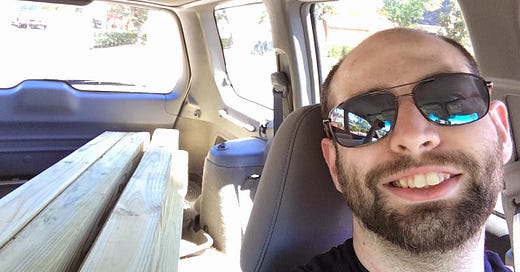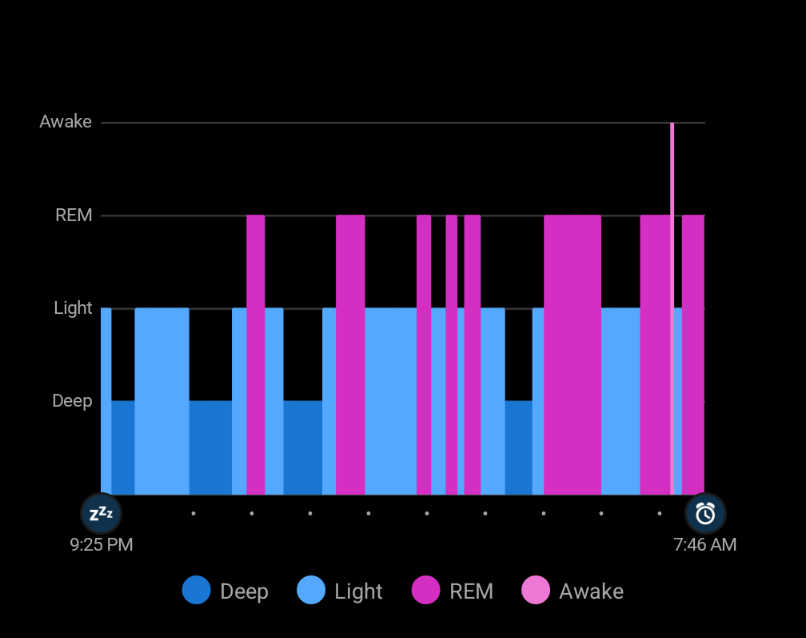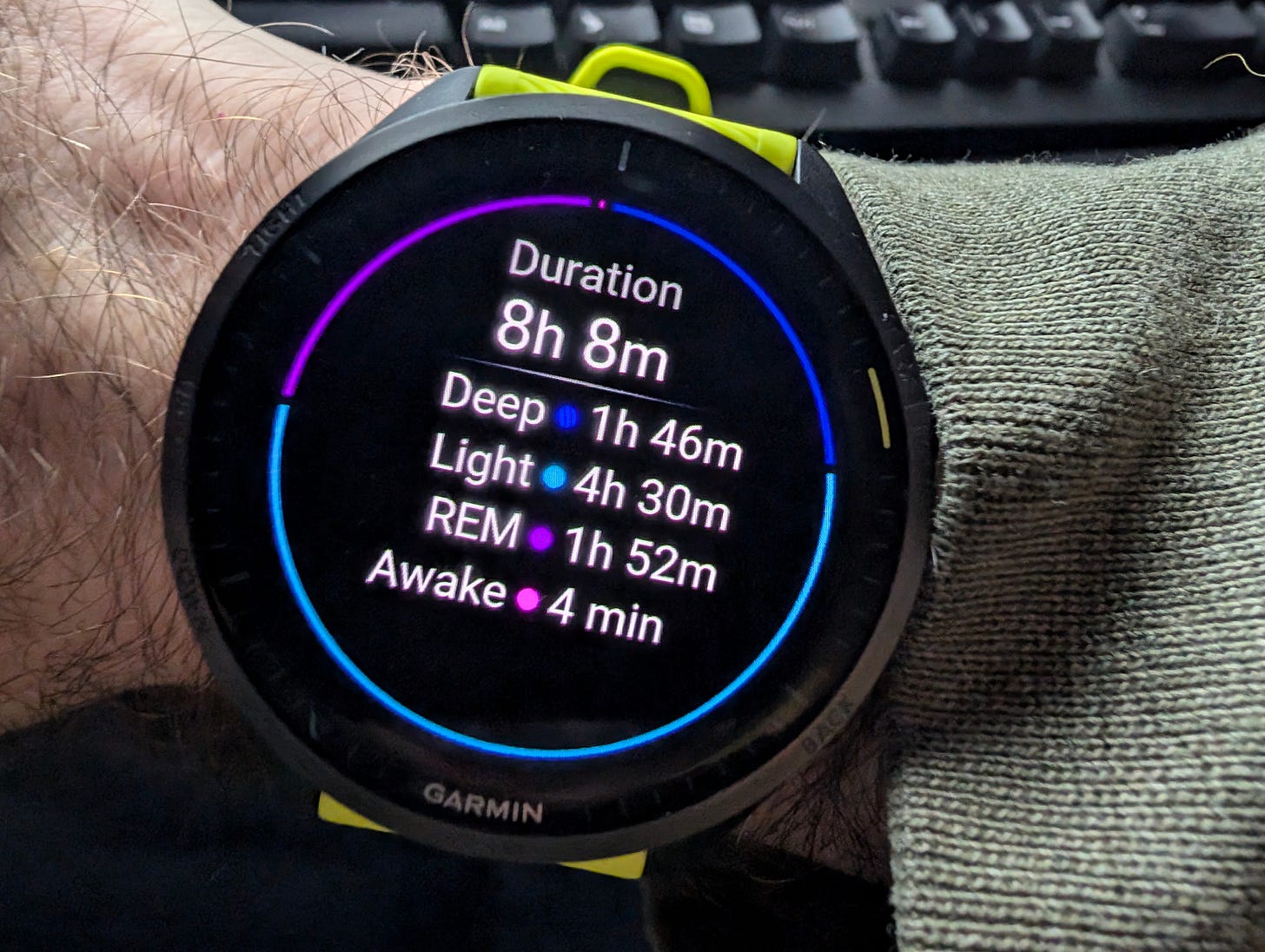There and Back Again: A Sleep Odyssey
In my 20's, I slept like a rock. Then I lost it. Now I'm getting it back with my "3S or SSS" method.
“Dave, are you still… you know… working? You do so much.”
A friend was visiting and helping me redo the exterior of my new workshop at the house I’d just bought. The year was 2015, I was 29 years old, and I was indeed working full time at Cisco Systems. In point of fact, I often stayed late at my job to dodge traffic and because I loved my job so much. I frequently got into hyper-focus while scripting and automating (an ability I can still activate at will to this day).

It’s true. Commuting two ways, often working for 9 hours (not always, mind you, Cisco was very generous with flexibility back then), and then coming home and building fences, repairing my workshop, and whatever else I was doing.
“The secret is good sleep.”
Back then, I didn’t track my sleep, but I had trained myself to switch off in bed. Day in and day out, I got excellent sleep every night.
Fast forward many years, between burnout and chronic health issues, my sleep has been in the dumps. I bought my first Fitbit a couple years ago specifically because I knew I was extremely stressed and just had no idea how bad it was. I started measuring sleep and stress and everything else. My sleep score was usually in the dumps: 60’s or 70’s (out of a hundred) and it was a rare day that I cracked the 80’s. In terms of time, I’d frequently only get 4.5 to 6 hours of sleep, and it was a godsend when I got any more than 7.
My New Years Resolution for 2024 was “to prioritize myself.” I’ve been sick for a while, and it turns out it wasn’t just burnout, but a serious gut infection (which honestly was probably started by burnout, but that’s another story).
Now, I’ve previously written about my sleep hygiene and bedtime routines. One thing I didn’t drive home is that treating my GI issues really dramatically improved my sleep quality. Anyways, for reference:
Recently, one night I was really struggling to get to sleep and I remember, “Wait… I had this solved in my 20’s! What did I forget? What went wrong along the way?”
So I lay there remembering everything I’d done to get nearly perfect sleep practically every night in my 20’s. I gathered my thoughts and memories and applied my systems thinking mind to them, to codify and articulate it in an easy-to-remember and easy-to-practice framework.
What came of it is the following!
SSS Method - My New/Old Secret Weapon
Method Overview
I call it the S3 or SSS method because it’s easy to remember:
Stop
Surrender
Somatic
Step one is to use “thought-stopping” to slow your thoughts, particularly intrusive or busy thoughts. Silly thoughts like remembering good things and such are fine. But intrusive thoughts are unpleasant and “busy thoughts” are “oughts” like “Oh, I need to do X, Y, and Z tomorrow!”
Step two is to use the “surrender” technique as taught by David Hawkins in his book Letting Go. The very short version of this technique is to fully open yourself to whatever emotions come up, rather than fighting them. Anger, fear, sadness, whatever. This is not the same as perseverating or wallowing. The key is you only feel it and don’t think about it. Most of the time, we react to emotions with thought: planning, dwelling, and repeating memories. But that’s not the same as just feeling them. When you fully surrender to an emotion, and allow that energy to move through you, it only lasts about 30 second to 2 minutes.
Step three, which I rarely get to since codifying this technique and practicing it (because I fall asleep by step 2) is “somatic focus” which basically means “focus on your body sensations.” I was inspired to add this one because I noticed that I fall asleep much faster if I use a heating pad. It gives you a sensation to focus on, rather than thoughts. Also, I remember as a teenager one of the best nights of sleep I got was in a leaky tent during a rainstorm when I was sleeping under my sleeping bag with nothing between me and the ground except the bottom tarp. Why? Because I was focusing on the fact that the sleeping bag was warm and protecting me from the dripping rain.
Now let’s get into each step of this technique a with bit more detail.
Thought Stopping
Back in my 20’s, I suffered from perseverating thoughts like many people, but I had a series of revelations.
“Wait a second… I’m going to forget all these thoughts by morning regardless of how important I think they are… so why I don’t I just cut to the chase and cut off these thoughts?”
This is called “thought-stopping” which is a technique I actually first learned about in the early 2000’s when reading about dating culture, of all things. What is commonly recognized as limerence today, the tendency to engage in bittersweet fantasies about a new crush, is actually not particularly healthy and I came across a blog that recommended using “thought-stopping” to halt those flights of fancy when you recognize them.
It turns out that this technique is actually very useful across your entire life. From relationships to work stress to sleep. It basically comes down to a few mantras that you can use for self-talk when you notice harmful, distracting, or unpleasant thoughts (i.e. intrusive or busy thoughts)
“This is not a helpful thought.”
“Stop. Stop. Stop. Stop.” (this one works well for very insistent intrusive thoughts, you basically drown it out by yelling stop at it until it gives up)
“I’m going to forget this by morning so it doesn’t matter.”
“I don’t like this so I’m not going to think about it anymore.”
These might seem basic, but the key is practice and repetition. By repeating these mantras in bed, you train your brain to stop thinking once your head hits the pillow. Since I’d practiced this extensively in my 20’s, it was easy to pick back up, now in my late 30’s. It took about a week or two of solid practice, but my results speak for themselves.

Most importantly, thought-stopping is critical for getting back to sleep when you wake up. The reason that my sleep was so awful was because of what’s called “terminal insomnia” meaning that I rarely have trouble getting to sleep, but I frequently wake up… and then my mind starts going…
Surrendering
This technique is a bit harder to describe, hence why David Hawkins needed an entire book. Below is my best attempt to compress it into one paragraph:
Surrendering to your emotions is like opening a door you've kept shut for far too long. It’s about letting go of the tightly held control we often exert over our feelings, allowing ourselves to fully experience them without judgment or resistance. When we surrender, we stop fighting against the tide of our emotions and instead let them wash over us, acknowledging their presence and power. This doesn’t mean wallowing or dwelling on negative feelings, but rather giving them space to exist and move through us. Imagine your emotions as a river, and instead of building dams to hold them back, you simply step into the current and let it carry you. It might feel scary at first, like you’re losing control, but in reality, you’re gaining a deeper understanding of yourself. As you practice surrender, you may find that emotions you've been pushing away for years begin to surface. Instead of tensing up or trying to push them back down, breathe into them. Feel where they sit in your body. Notice their texture, their temperature, their weight. And most importantly, remind yourself that it's okay to feel this way. By fully embracing your emotions, you allow that energy to move through you, much like the Litany of Fear from Dune teaches: “I will face my fear. I will permit it to pass over me and through me.” This process might feel intense at first, but it’s often surprisingly brief. What seemed like an overwhelming emotion that might last forever often dissipates within minutes when we truly surrender to it. In doing so, we not only process our feelings more effectively but also learn to trust ourselves and our ability to handle whatever life throws our way.
By the way, the combination of surrender and breathing is how you cure anxiety. Yes cure anxiety. I categorically reject the medical establishment’s assertion that general anxiety cannot be cured. See the book Rewire Your Anxious Brain for more. You surrender to the anxiety, and allow your body to twitch and shake if needed, and just keep breathing.
Okay, but why? Why does this help? When emotions, particularly negative ones, are stuck in a holding pattern, they keep us awake. It’s that simple. It’s better to discharge the emotions and let them flow through you, which then allows them to be muted and dispelled. And yes, they do dissipate.
Remember: you’ve fallen asleep, eventually, every night (even if only for an hour or two). Don’t worry about that part. All you have to do is set the stage and let nature run its course.
Somatic Focus
This one is very helpful, particularly when you’re having trouble falling asleep. Also, for people with active brains, you can’t just… not think. That’s not possible! However, what you can do is direct your brain at very specific things, and I found that directing your focus at your body is best. I don’t full know how or why this works, but I have some hypotheses.
Consider our paleolithic ancestors. If they felt safe enough, after a good meal by the fire, and now ensconced in their tent, yurt, or hut, rather than focusing on tomorrow or wild bears, they’d probably focus on how good and safe they felt. This signals to their brain and body “There’s nothing to worry about, time to shut down.”
Speaking of safety, we’re so used to being safe and comfortable in our bedrooms today that we often take it for granted. But we still have an evolutionary memory of being prey to larger predators. So, from your lizard-brain’s perspective, whatever you’re thinking about might be a lethal threat, so you need to stay vigilant. However, if you turn your thoughts to your body, fixating on how good and safe you feel, this probably activates a very primitive circuit that evolved in the brain to say “Okay, we’re safe and healthy right now, time to rest and recharge while we can!”
If you use blankets, a heating pad, a fan, and a noise generator, I also suspect that this activates a somewhat primitive set of circuits that tells your body “I’m outside (wind, night noises), but I’m also wrapped up and safe, beside a campfire (which represents safety).” I gave my wife a full heated blanket for her birthday and I think that makes me the best husband of the year.
Again, the pattern all orbits around atavistic and evolved traits that signal safety and security. Plus, if you have ADHD-brain, it gives you something to actually fixate on!
As I mentioned earlier, I rarely get to step 3 nowadays. Usually I just focus on thought-stopping and surrendering and it only takes me a few minutes to fall asleep. Again, my data speaks for itself. Only 4 minutes of being awake last night!
Now let’s do a recap and overview.
Recap and Overview
First and foremost, you have the most immediate control over your nightly routines and habits. Rather than regurgitate them, just check out Bryan Johnson’s video. Here, he gives 6 tips for getting better sleep on a tactical level. What I mean by “tactical” is that these are choices that you can implement immediately and without much practice.
So, here’s the high level overview for all my sleep advice:
Implement tactical choices, such as those listed in the video above, good sleep hygiene, and so on. A sleep tactic is something that you can implement immediately, such as turning on a fan, getting a noise generator, and so on.
Practice the SSS technique above, which does take some time to learn, practice, and train your brain. The best time to practice this technique was years ago. The second best time is now. It might take a week or two to start to get the hang of it, but it’s worth it (and beside, you’re going to be laying in bed anyways).
Improve your physical health. Lose weight, take care of chronic issues, learn nasal breathing. I recommend books like Eat Dirt by Dr. Josh Axe and Breath by James Nestor. Just implementing nasal breathing lowered my blood pressure and enhanced my sleep a bit. Curing my gut issues reduced inflammation further. This is a much longer project, one I’ve been at all year (so almost 11 months now), but I’ve lost 10 pounds and I’m more active than I’ve been in many years.
With all that said, I hope you get some good sleep!





